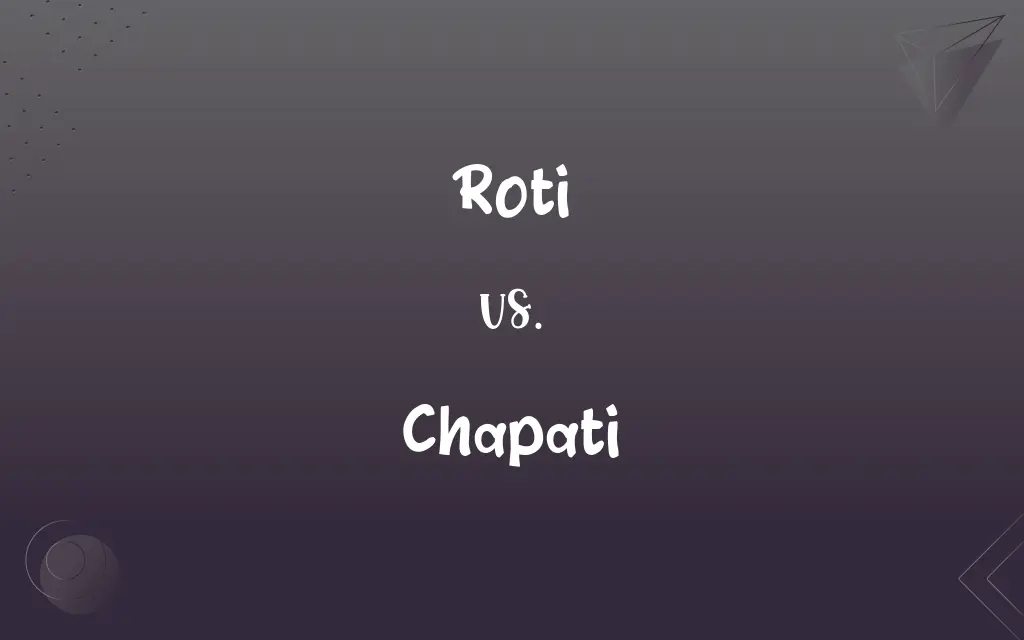Roti vs. Chapati: What's the Difference?
Edited by Janet White || By Harlon Moss || Updated on October 20, 2023
Roti is a generic term for unleavened bread in Indian cuisine, while chapati is a specific type of thin, whole-wheat Indian bread.

Key Differences
Roti is a general term that encompasses various types of unleavened bread in Indian cuisine. The name "roti" is derived from the Sanskrit word which means "bread". On the other hand, chapati is a specific kind of roti made from whole wheat flour. It is a staple in many parts of India and is known for its thin, soft texture.
Chapati has a more defined preparation and cooking method. It's traditionally made using whole wheat flour mixed with water, kneaded into a dough, rolled out into thin circles, and cooked on a flat skillet called a "tawa". Roti, in its broader sense, can be made from different types of flours and might not always be as thin or soft as a chapati.
While both roti and chapati are integral parts of Indian meals, chapati holds a special place in North Indian households. On the flip side, the term roti is more commonly used in South Asia to describe various bread types, including those that are not similar to chapati.
In some contexts, the terms roti and chapati might be used interchangeably, especially outside of India where the nuances between the different types of breads might not be as recognized. However, in an authentic setting, while all chapatis are rotis, not all rotis are chapatis.
Comparison Chart
Origin of Name
Derived from Sanskrit meaning "bread".
Specific to a type of Indian bread.
ADVERTISEMENT
Flour Type
Can be made from various flours.
Typically made from whole wheat flour.
Texture
Varies depending on the type.
Thin and soft.
Preparation
General term for unleavened bread.
Specific preparation and cooking method.
Geographic Use
More commonly used term in broader South Asia.
Specific to many North Indian households.
Roti and Chapati Definitions
Roti
An unleavened bread popular in South Asian cuisine.
She spread some butter on the hot roti before serving.
ADVERTISEMENT
Chapati
A staple food often consumed with vegetables or meat dishes.
Chapati and butter chicken make a delightful combo.
Roti
A round bread, often cooked on a flat skillet.
She expertly flipped the roti on the tawa until it was golden brown.
Chapati
A thin, whole-wheat flatbread from North India.
The chapati was soft and paired perfectly with the lentil dal.
Roti
A versatile bread, made from various flours.
The bajra roti is a great gluten-free option.
Chapati
A bread known for its light texture and rich flavor.
Freshly made chapati has an aroma that's hard to resist.
Roti
A flatbread often paired with curries or cooked vegetables.
I prefer roti with my chicken curry.
Chapati
An Indian bread, rolled out and cooked on a tawa.
He prepared chapati using his grandmother's recipe.
Roti
A staple food in many South Asian households.
Dinner isn't complete without fresh roti on the table.
Chapati
A popular variant of roti, made without yeast or leavening agents.
Chapati is a healthier bread option for diabetics.
Roti
See chapati.
Chapati
A flat, unleavened, disk-shaped bread of northern India, made of wheat flour, water, and salt. Also called roti.
Roti
A kind of unleavened flatbread commonly consumed in South Asia and the Caribbean.
Nepalis eat sweet fried rice-flour doughnuts called sel roti.
Chapati
A flat, unleavened bread from northern India and Pakistan.
Chapati
A flat pancakelike bread cooked on a griddle, originating in India.
Chapati
Flat pancake-like bread cooked on a griddle
FAQs
Is chapati a type of roti?
Yes, while all chapatis are rotis, not all rotis are chapatis.
Are roti and chapati the same in nutrition?
Both are similar, but specifics depend on the flour used and preparation.
What flour is roti made from?
Roti can be made from various flours, while chapati is typically whole wheat.
What is chapati?
Chapati is a specific type of thin, whole-wheat Indian bread.
Is roti gluten-free?
It depends on the flour used; for example, bajra roti is gluten-free.
What is roti?
Roti is a general term for unleavened bread in South Asian cuisine.
How is chapati cooked?
Chapati is rolled thin and cooked on a flat skillet, or tawa.
What's the difference in taste between roti and chapati?
Chapati has a distinct whole wheat taste, while roti's taste depends on its flour type.
Are rotis vegan?
Yes, traditional roti and chapati are vegan as they're made without animal products.
Why is my chapati not puffing?
This can be due to the dough's consistency, rolling technique, or the heat of the skillet.
Can roti be frozen?
Yes, both roti and chapati can be frozen and reheated.
Are roti and tortilla the same?
No, while similar in appearance, they have different ingredients and cultural origins.
Is roti eaten daily in India?
Yes, roti, including chapati, is a staple in many Indian households.
Which is healthier, roti or chapati?
Both are healthy, but whole-wheat chapatis have the added benefits of whole grains.
What do you eat chapati with?
Chapati can be paired with a variety of dishes, from curries to dry vegetables.
How long can chapati dough be stored?
In the fridge, chapati dough can last 1-2 days; however, it's best when fresh.
Why is roti important in South Asian cuisine?
Roti serves as a staple carbohydrate source and complements main dishes.
How do you keep chapati soft?
Storing in a cloth-covered container keeps chapati soft after cooking.
Can you use all-purpose flour for chapati?
Traditional chapati uses whole wheat, but all-purpose flour can be used with a different texture.
Do you need oil for chapati?
Traditionally, chapati is made without oil, but some variations might include it.
About Author
Written by
Harlon MossHarlon is a seasoned quality moderator and accomplished content writer for Difference Wiki. An alumnus of the prestigious University of California, he earned his degree in Computer Science. Leveraging his academic background, Harlon brings a meticulous and informed perspective to his work, ensuring content accuracy and excellence.
Edited by
Janet WhiteJanet White has been an esteemed writer and blogger for Difference Wiki. Holding a Master's degree in Science and Medical Journalism from the prestigious Boston University, she has consistently demonstrated her expertise and passion for her field. When she's not immersed in her work, Janet relishes her time exercising, delving into a good book, and cherishing moments with friends and family.































































